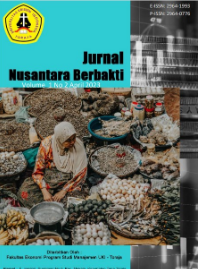Pendampingan Disain HACCP Plan untuk Peningkatan Mutu Keamanan Pangan Produk Usaha Kecil Pangan Bakery di Bogor
DOI:
https://doi.org/10.59024/jnb.v2i1.301Keywords:
Bakery, Small Food Industry, Food Safety, HACCPAbstract
The bakery industry is a sector that continues to grow through the crisis period in 2021 when Indonesia managed to record the highest bread sales in the Southeast Asia region with total transactions reaching USD 18.7 billion. Mak MPOEQ cake house in Bogor is one of the small food industries that has continued to produce during the Covid 19 pandemic until now. Bakery products are sensitive to contamination so they can easily and potentially spread food safety hazards. An integrated system of control and quality management of manufactured products is required, which makes it possible to implement timely measures to prevent, identify and eliminate deficiencies and errors in production, to provide reliable information about the products produced to consumers. To date, a system based on the use of Hazard Analysis Critical Control Points (HACCP) principles has been able to overcome these food safety problems well. The design of the HACCP system at Mak MPOEQ's cake house has been implemented through a community service mentoring program for staff from FMIPA Pakuan University in the period April-December 2023. The coaching is carried out following the stages of implementing the HACCP system as stated in SNI CAC/RCP 1 of 2011 issued by National Standardization Agency. The basic requirements for HACCP itself have been prepared by partners since 2021. The results of the hazard analysis carried out on the MPOEG Mak Cake House production system found 7 significant hazards out of the 20 hazards evaluated. Next, using the Codex decision tree, 4 CPPs were determined from the 7 hazards, namely egg receiving, flour sifting, filing, and vla cooking. Based on these 4 CCPs, a HACCP Plan has been prepared which focuses control on cleanliness when receiving eggs, physical contamination when sifting flour, sanitary bacteria from worker cross-contamination, and temperature and cooking time. All controls are carried out per activity batch and verified periodically.
References
Badan Standardisasi Nasional (BSN). 2011. Standar Nasional Indonesia-SNI/RCP 01-2011 : Rekomendasi Nasional Panduan Pengolahan Pangan Higienis. BSN, Jakarta
Budi, A.S.S., dan T. Mahmudiono. 2021. Penerapan Sistem Hazard Analysis Critical Control Point (HACCP) pada Produk Banana Cake di Aerofood ACS Surabaya. Budi. Amerta Nutr (2021). 211-222
Bukhovets, V., D. Shkurina, and T. Demina. 2022. Quality and safety management at bakeries. BIO Web of Conferences 43, 03023 (2022)
Foodwatch. 2014. Surveilan Keamanan Pangan Industri Kecil Rumah Tangga di Indonesia. BPOM, Jakarta
Hermawan, A.S. Aryani, F.D.Sulistyono, dan L.Tsaniyah. 2019. Rancangan Sistem Manajemen Keamanan Pangan pada Industri Pengolahan Jus Buah Di Kabupaten Bogor. PROSEDING Seminar Nasional Hasil Pengabdian Kepada Masyarakat SINDIMAS 2019 STMIK Pontianak, 29 Juli 2019. Hal 189-193.
Hermawan, F,D,Slistyono, dan L. Tsaniyah. 2022. Pembinaan Penerapan Protokol Pencegahan COVID 19 Pada Sistem Produksi Pangan Usaha Kecil di Bogor. J-Abdi. Vol 1. No. 8. 1843-1852
Jubayer, M.F., M.S. Hossain, M. Al-Emran and M.N. Uddi. 2022. Implementation of HACCP Management System in a Cake Manufacturing Company in Dhaka, Bangladesh: A Case Study. Journal of Food Quality Volume 2022, Article ID 5321333, Hindawi
Kushwah, A. and R. Kumar. 2018. HACCP - Its Need And Practices. Acta Chemica Malaysia (ACMY) 1(2) (2017) 01-05.
Kamboj, S., N. Gupta, J. D Bandral, G. Gandotra and N. Anjum. 2020. Food safety and hygiene: A review. International Journal of Chemical Studies 2020; 8(2): 358-368.
Kushwah,A. dan R. Kumar. 2017. HACCP - Its Need And Practices. Acta Chemica Malaysia (ACMY) 1(2) (2017) 01-05
Lestari, TRP. 2020. Penyelenggaraan Keamanan Pangan sebagai Salah Satu Upaya Perlindungan Hak Masyarakat sebagai Konsumen. Aspirasi: Jurnal Masalah-Masalah Sosial | Volume 11, No. 1 Juni 2020. 57-72
Marques, N.R.P., , J.C. de Oliveira Matias, R.R.B.Teixeira, and F.M.R.P. Brojo. 2012. Implementation of Hazard Analysis Critical Control Points (HACCP) in a SME: Case Study of a Bakery. Pol. J. Food Nutr. Sci., 2012, Vol. 62, No. 4, pp. 215-227
Mumpuni, F.S., Hermawan, dan S. Hasibuan. 2014. Rancangan Implementasi Sistem Manajemen Keamanan Pangan pada UKM Pengolahan Ikan Rakyat. Prosiding Seminar Nasional Industrial Engineering Conference, 2014; Hal. 83-89. ISBN 978-602-70259-2-9
Noer, H.F. 2023. Prospek Cerah Bisnis Bakery. Food Review Indonesia. https://www.foodreview.co.id
Pratiwi, Y.S., Rahmawati, M.A. Kurnianto, H. Munarko, Y.A.Sanjaya, dan I. Defri. 2022. Teknologu Bakery dalam Terapan. CV. SATYA MANDIRI, Jember.
Rahayu, W.P., H. Nababan, P. Hariyadi, dan Novinar. 2012. Keamanan pangan dalam Rangka Peningkatan Daya Saing Usaha Mikro, Kecil, dan Menengah untuk Penguatan Ekonomi Nasional. Makalah WNPG X, Jakarta 21-22 Nopember 2012.
Rochman, S.F., A. Nurmaydha, dan G.R. Pratama. 2020. Penerapan Sistem Hazard Analysis Critical Control Point (HACCP) Pada Industri Roti. Agroindustrial Technology Journal 04 (01) (2020) 53-64
Sucipto, P.W. Sumbayak, dan C,G. Perdani. 2020. Evaluation of Good Manufacturing Practices (GMP) and Sanitation Standard Operating Procedure (SSOP) Implementation for Supporting Sustainable Production in Bakery SMEs. Turkish Journal of Agriculture - Food Science and Technology, 8(1): 7-12,
Tsaniyah, L dan Hermawan. 2022. Sistem Manajemen Keamanan Pangan pada Industri Pakan PT Insan Cendekian Mandiri Group, Padang.
Downloads
Published
How to Cite
Issue
Section
License
Copyright (c) 2023 Erniyati Erniyati, Puspa Citra, Legis Tsaniyah, Hermawan Hermawan

This work is licensed under a Creative Commons Attribution-NonCommercial-ShareAlike 4.0 International License.








